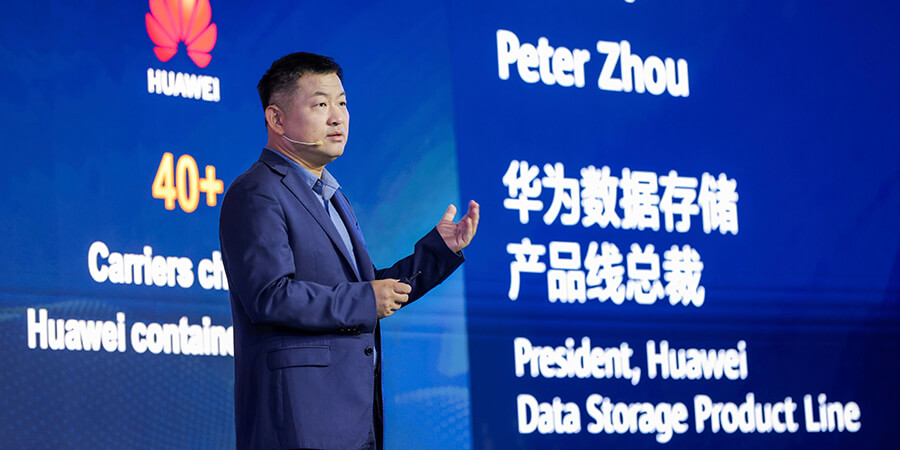Carriers have been at the forefront of the digital transformation over the past few years. The introduction of cloud services, B-to-B (business-to-business) technologies, and video streaming has created new growth potential for carriers. However, these new services place greater demands on IT infrastructure. Efficient data training, cost-effective data storage, and robust data resilience have all emerged as key challenges for carriers, particularly as the threat of ransomware grows.
During his keynote speech at the Huawei Product & Solution Innovation Launch at MWC Shanghai 2023, Peter Zhou, President of the Huawei IT Product Line, highlighted Huawei’s vision of building a more trustworthy data infrastructure for the carrier industry.
While the boom of the digital and intelligent era is fast approaching, it has brought forth new challenges for carriers in their data infrastructure construction.
Mr. Zhou said, “Massive unstructured data enters the production decision-making system, causing explosive data growth. Data resilience risks caused by human factors are becoming more and more serious.” Huawei highlights five major challenges: managing multi-cloud ecosystems; the expansion of generative AI; cloud business; cross-cloud data scheduling and ransomware threats. Addressing these difficulties necessitates the use of innovative solutions and technologies.
Data Storage Support for Emerging Applications
The number of cloud-native applications that are migrating from the public cloud to on-premise data centers is on the rise. With this, traditional data center infrastructures are having a hard time meeting the demands of supporting these new applications. Huawei believes that the container ecosystem should be fully supported for it to be able to adapt to these emerging applications.
Mr. Zhou showcased what Huawei has to offer when it comes to storage: “Huawei storage provides the standard CSI interface and the extended container DR interface CDR, which can support the container ecosystem. When upper-layer applications are cloudified, storage can seamlessly interconnect with different data centers and build data persistence capabilities.”
Currently, more than 40 carriers have chosen Huawei's container storage solution.
Carriers face both opportunities and challenges as generative AI booms this year. The surge in new applications and new data, coupled with growing AI capabilities that pose greater storage requirements, might be overwhelming for some, especially from a management perspective. To help carriers address this dilemma, Mr. Zhou shared that Huawei has to continuously adapt and transform to advance IT products and technologies whenever a new type of data or application emerges.
“Particularly in the area of data storage, we must adapt to such changes with innovative technologies and the best software and hardware. This drives our decision to adopt traditional SANstorage and NASstorage solutions,” Mr. Zhou explained. “This year, we will vigorously develop scale-out storage to enable new applications of massive data as a strategic direction forward.”
Addressing challenges to exponential increase of LLM parameters and data, time-consuming data preprocessing, and unstable training process, Mr. Zhou shared that Huawei’s AI storage uses cutting-edge technologies, including efficient backup and recovery of checkpoints and near-data processing, to improve training preprocessing efficiency and enable training of trillion-parameter big models.
Resolving Problems from Data Gravity with Intelligent Data Fabric
Huawei OceanDisk, the industry’s first professional storage system designed for diskless architecture, also took center stage. Mr. Zhou highlights how Huawei OceanDisk can address the challenges of data migration from traditional data centers’ “server + local disk” architecture.
He said, “Through architecture innovation, professional storage capabilities help large-scale cloud data centers achieve energy saving, high performance, and high reliability. China Telecom Cloud uses OceanDisk to support services such as video, development and testing, and AI-based computing services, saving space and energy consumption by 40%.”
A Focus on Resilient Data Storage
Moreover, Mr. Zhou also emphasized how Huawei's storage solutions incorporate numerous levels of protection features: “Huawei storage uses ransomware identification, secure snapshots, backup storage, and physical isolation areas to build multi-layer protection and internal security, ensuring that a clean copy of enterprise data is always available.” Essentially, Huawei's IT Product Line provides comprehensive solutions for constructing dependable data infrastructure, drive digital productivity forward for carriers. Moving forward, Huawei will continue to pave the road for a resilient and competitive future in the carrier business with its innovative storage solutions.
By Issam Eid (Editor-in-Chief of Telecom Review Africa and Arabia)





